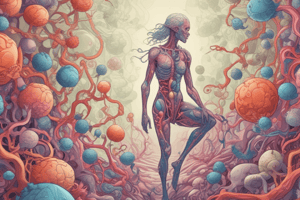Podcast
Questions and Answers
How many cells are there in the adult human body?
How many cells are there in the adult human body?
- 100 million
- 1 billion
- 37,000,000,000,000 (correct)
- 10,000
What is a common feature of most cells?
What is a common feature of most cells?
- They are all visible without a microscope
- They all have the same shape
- They all have different internal structures called organelles (correct)
- They all function in exactly the same way
Which unit is considered one of the hardest in the course?
Which unit is considered one of the hardest in the course?
- General Biology
- Human Anatomy
- Cells and Tissues (correct)
- Genetics
What are organelles in a cell similar to?
What are organelles in a cell similar to?
How big is a human cell typically?
How big is a human cell typically?
What is the approximate number of cells in an adult human body based on the text?
What is the approximate number of cells in an adult human body based on the text?
What is the classification based on the number of layers of cells in epithelial tissue?
What is the classification based on the number of layers of cells in epithelial tissue?
Which type of epithelial tissue looks like it has multiple layers but all cells are actually attached to the basement membrane?
Which type of epithelial tissue looks like it has multiple layers but all cells are actually attached to the basement membrane?
What is the function of cilia in ciliated epithelial tissues?
What is the function of cilia in ciliated epithelial tissues?
Which type of tissue has a top layer used to name the entire tissue?
Which type of tissue has a top layer used to name the entire tissue?
What is the classification of epithelial tissue with more than one layer where only the deepest layer is attached to the basement membrane?
What is the classification of epithelial tissue with more than one layer where only the deepest layer is attached to the basement membrane?
Which type of epithelial tissue has cilia on its free surface?
Which type of epithelial tissue has cilia on its free surface?
What is the main cause of jaundice?
What is the main cause of jaundice?
Which layer of the skin contains sensory receptors?
Which layer of the skin contains sensory receptors?
What is the function of sebaceous glands?
What is the function of sebaceous glands?
Which layer of the skin contains larger blood vessels, hair follicles, and glands?
Which layer of the skin contains larger blood vessels, hair follicles, and glands?
What inhibits bacteria in sweat glands?
What inhibits bacteria in sweat glands?
In which individuals is jaundice common due to immature livers?
In which individuals is jaundice common due to immature livers?
What is the function of epithelial tissue?
What is the function of epithelial tissue?
How many chromosomes do humans have?
How many chromosomes do humans have?
What is the main information encoded by genes?
What is the main information encoded by genes?
What type of cell doesn't have a specific function other than to divide?
What type of cell doesn't have a specific function other than to divide?
What gives us all unique characteristics according to the text?
What gives us all unique characteristics according to the text?
How many primary tissue types are mentioned in the text?
How many primary tissue types are mentioned in the text?
What is the main function of the stratum corneum in the epidermis?
What is the main function of the stratum corneum in the epidermis?
How are the cells in the stratum corneum different from other skin cells?
How are the cells in the stratum corneum different from other skin cells?
What is the approximate number of skin cells lost per day by an individual?
What is the approximate number of skin cells lost per day by an individual?
Which pigment is the main determinant of skin color?
Which pigment is the main determinant of skin color?
Where are melanocytes located in the epidermis?
Where are melanocytes located in the epidermis?
What stimulates the over-production of melanin in the skin?
What stimulates the over-production of melanin in the skin?




